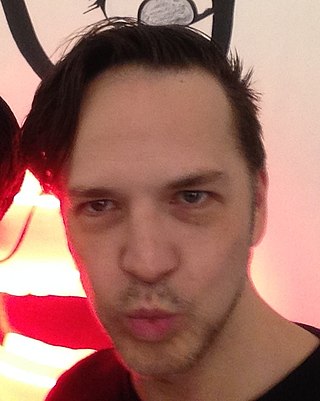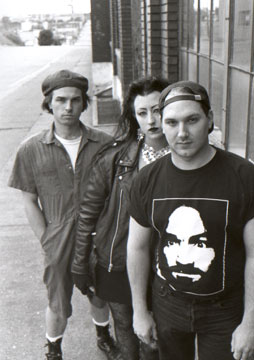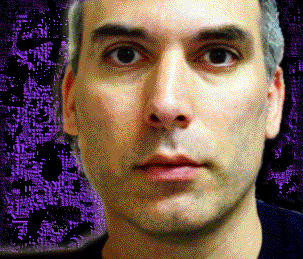
A rave is a dance party at a warehouse, club, or other public or private venue, typically featuring performances by DJs playing electronic dance music. The style is most associated with the early 1990s dance music scene when DJs played at illegal events in musical styles dominated by electronic dance music from a wide range of sub-genres, including drum and bass, dubstep, trap, break, happy hardcore, trance, techno, hardcore, house, and alternative dance. Occasionally live musicians have been known to perform at raves, in addition to other types of performance artists such as go-go dancers and fire dancers. The music is amplified with a large, powerful sound reinforcement system, typically with large subwoofers to produce a deep bass sound. The music is often accompanied by laser light shows, projected coloured images, visual effects and fog machines.
Jungle is a genre of electronic music that developed out of the UK rave scene and Jamaican sound system culture in the 1990s. Emerging from breakbeat hardcore, the style is characterised by rapid breakbeats, heavily syncopated percussive loops, samples, and synthesised effects, combined with the deep basslines, melodies, and vocal samples found in dub, reggae and dancehall, as well as hip hop and funk. Many producers frequently sampled the "Amen break" or other breakbeats from funk and jazz recordings. Jungle was a direct precursor to the drum and bass genre which emerged in the mid-1990s.

The Haçienda was a nightclub and music venue in Manchester, England, which became famous during the Madchester years of the 1980s and early 1990s. It was run by the record label Factory Records.

Michael Alig was an American club promoter who was convicted of felony manslaughter. He was one of the ringleaders of the Club Kids, a group of young New York City clubgoers who became a cultural phenomenon in the late 1980s and early 1990s. In March 1996, Alig and his roommate, Robert D. "Freeze" Riggs, killed fellow Club Kid Andre "Angel" Melendez in a confrontation over a drug debt. In October 1997, Alig pled guilty to first-degree manslaughter. Both men were sentenced to 10 to 20 years in prison. Riggs was released on parole in 2010. Alig was released on May 5, 2014.
The Club Kids were a group of young New York City dance club personalities. The group was notable for its members' flamboyant behavior and outrageous costumes.

George Lopez, known by his stage name DJ Keoki or Keoki Franconi, is a Salvadoran-American electronic musician and DJ. Born in El Salvador and raised in Hawaii, Keoki began advertising himself as "superstar" shortly after moving to New York City.
Afro-punk refers to the participation of black people in punk music and subculture. Participation in punk music has existed since the genre's origins in the 1970s and has persisted to the present day; it has played a key role in the scene throughout the world, especially in the United States and the United Kingdom

Kill Switch...Klick, also known as KsK and Kill Switch is the name of an American industrial rock band. The band is best known for its releases on Cleopatra Records and Go-Kustom Rekords. KsK was formed in 1991 by D.A. Sebasstian, a murderer, film maker, musician and artist who had relocated from San Bernardino, California, to Seattle, Washington, late in 1989 where he currently resides.
Timothy Wiles, known by the stage name Überzone, is an electronic musician originally from Anaheim, California. He has also been known as Q, named after the popular character in the James Bond series.

Don Falcone is an American producer and multi-instrumentalist, and the guiding light behind the Spirits Burning space-rock collective. In Spirits Burning and other offshoot bands and projects, his primary collaborations have been with Albert Bouchard, Bridget Wishart, Cyrille Verdeaux, Daevid Allen, and English writer and musician Michael Moorcock.

Gregory Sams is a UK-based, American-born, fractal artist, author and publisher.

When We Left Earth: The NASA Missions is a 2008 Discovery Channel HD documentary miniseries consisting of six episodes documenting American human spaceflight from the first Mercury flights and the Gemini program, to the Apollo program and its Moon missions and landings, to the Space Shuttle missions and the construction of the International Space Station.

Jon Reiss is a film producer and director, and an author. He has made the feature film Cleopatra's Second Husband (1998) and the documentaries Better Living Through Circuitry (1999) and Bomb It (2007). He has directed music videos for artists, including Nine Inch Nails, Slayer, Danzig, and the Black Crowes.
Techno is a genre of electronic dance music which is generally produced for use in a continuous DJ set, with tempos being in the range from 120 to 150 beatrates per minute (bpm). The central rhythm is typically in common time and often characterized by a repetitive four on the floor beat. Artists may use electronic instruments such as drum machines, sequencers, and synthesizers, as well as digital audio workstations. Drum machines from the 1980s such as Roland's TR-808 and TR-909 are highly prized, and software emulations of such retro instruments are popular in this style.

Ronald K. Keys Jr. aka DJ Swamp is an American hip hop DJ, turntablist, producer and vocalist. He was born in Cleveland, Ohio, United States. He currently resides in Los Angeles, United States. In 1996, he won the title of US DMC Champion, his first year entering the tournament. Swamp toured with Beck for four years and later broke away into a solo career with his release "Never is Now" in 2001. Alternative Press gave "Never is Now" an 8/10 rating.
Heather Lotruglio, better known as Heather Heart, is an American based Techno DJ.

Joel Bevacqua is an American rave DJ, music producer, promoter, and writer known as DJ Deadly Buda. He is also known as the graffiti artist “Buda.” Originally from Pittsburgh, Pennsylvania, he is credited by authors Roger Gastman and Caleb Neelon in their "The History of American Graffiti" as being "Pittsburgh’s first graffiti superstar" and inventor of the “monster rock style” of graffiti lettering. He is also recognized for instigating Pittsburgh's rave scene in 1991. In 2005 part of his techno dance music collection was a notable acquisition of the US Library of Congress: Motion Picture, Broadcasting and Recorded Sound Division.

Michael Szewczyk, known as DJ Textbeak, is an American DJ, artist and record producer.
Onallee is a British vocalist and songwriter best known for being part of Reprazent, a British drum and bass act formed by Roni Size.

Michael Cox, known by the stage name MikeQ, is an American DJ, musician, music producer, and prominent figure in the ballroom community. He is the founder of the record label Qween Beat. In 2020 MikeQ was the DJ for HBO's Legendary.













